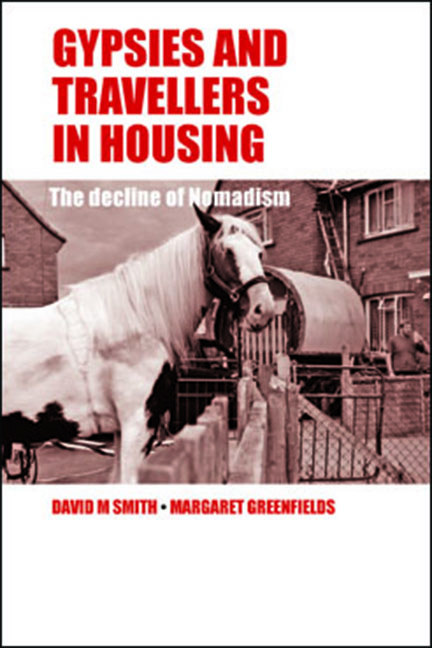Book contents
- Frontmatter
- Contents
- List of tables
- Acknowledgements
- Foreword
- one Introduction
- two Space, surveillance and modernity
- three Gypsies, nomads and urbanisation: a social history
- four The research sites and population sample
- five Routes into housing
- six Housing transitions
- seven Gypsies, Travellers and gorjers: conflict and cooperation
- eight Recreating community
- nine Young people in housing: aspirations, social relations and identity
- ten Conclusion
- Appendix A Methodologies
- Appendix B Glossary of words and terms
- References
- Index
four - The research sites and population sample
Published online by Cambridge University Press: 03 February 2022
- Frontmatter
- Contents
- List of tables
- Acknowledgements
- Foreword
- one Introduction
- two Space, surveillance and modernity
- three Gypsies, nomads and urbanisation: a social history
- four The research sites and population sample
- five Routes into housing
- six Housing transitions
- seven Gypsies, Travellers and gorjers: conflict and cooperation
- eight Recreating community
- nine Young people in housing: aspirations, social relations and identity
- ten Conclusion
- Appendix A Methodologies
- Appendix B Glossary of words and terms
- References
- Index
Summary
Introduction
In this chapter we set out the sites of the various research studies and introduce existing data which we have drawn upon to support our findings, for example Gypsy Traveller Accommodation Assessments (GTAAs). In addition we discuss how we developed the follow-up qualitative studies into the experiences of housed Gypsies and Travellers which form the core of this text.
As noted previously, GTAAs arose in response to New Labour's in-depth policy review of Gypsy and Traveller circumstances which commenced in 2003 (Greenfields, 2007a). The findings from the review and consideration of representations from activists, academics and Gypsy and Traveller community groups led to specific requirements being inserted into the detailed policy guidance (implemented as Circular 01/06). These specified how local authorities should respond to planning applications and identify land for new sites. The Planning Circular was inextricably linked into the 2004 Housing Act which placed a duty on local authorities to review the current and future accommodation needs of all local residents. Guidance on undertaking GTAAs was subsequently produced, which provided detailed advice on the assessment of need for Gypsy and Traveller communities (CLG, 2007). Importantly, in response to an accumulation of anecdotal evidence from community groups and academics that large numbers of local authority housing placements broke down and lobbying for their inclusion in GTAA surveys, the needs of Gypsies and Travellers residing in ‘bricks and mortar’ were for the first time incorporated into the reviews. The inclusion of ‘housed’ Gypsies and Travellers marked recognition of the fact that aspirations to live in a culturally ‘appropriate’ or traditional way were not necessarily extinguished once a family had become ‘settled’.
Once completed, the results of GTAAs surveys were to be considered and built into Local Development Frameworks and Regional Spatial Strategies (Richardson, 2007a; Greenfields, 2008). For the first time therefore researchers were able to draw on evidence relating to the household situation of Gypsies and Travellers in ‘bricks and mortar’, a community who were previously invisible in administrative statistics once they were no longer living in caravans and hence subject to the bi-annual ‘caravan count’ (Niner, 2004). As considered below there are significant methodological difficulties in attempting to accurately assess the numbers of housed Gypsies and Travellers in any area.
- Type
- Chapter
- Information
- Gypsies and Travellers in HousingThe Decline of Nomadism, pp. 75 - 88Publisher: Bristol University PressPrint publication year: 2013



